
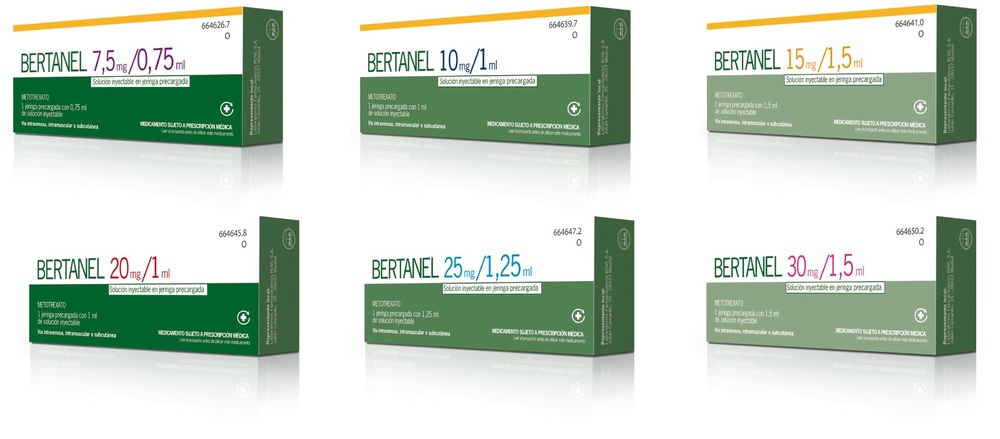
БЕРТАНЕЛ 7,5 мг/0,75 мл РОЗЧИН ДЛЯ ІН'ЄКЦІЙ У ПЕРЕДНАПОВНЕНИХ ШПРИЦАХ


Інструкція із застосування БЕРТАНЕЛ 7,5 мг/0,75 мл РОЗЧИН ДЛЯ ІН'ЄКЦІЙ У ПЕРЕДНАПОВНЕНИХ ШПРИЦАХ
Вступ
Опис: інформація для користувача
Бертанель 7,5 мг/0,75 мл розчин для ін'єкцій у попередньо наповненому шприці
Бертанель 10 мг/1 мл розчин для ін'єкцій у попередньо наповненому шприці
Бертанель 15 мг/1,5 мл розчин для ін'єкцій у попередньо наповненому шприці
метотрексат
Вважно прочитати уважно весь опис перед початком використання препарату, оскільки він містить важливу інформацію для вас.
- Збережіть цей опис, оскільки вам може знадобитися знову його прочитати.
- Якщо у вас виникли питання, проконсультуйтеся з вашим лікарем або фармацевтом.
- Цей препарат призначений тільки для вас, і не слід давати його іншим людям, навіть якщо вони мають такі самі симптоми, оскільки це може їм нашкодити.
- Якщо ви відчуваєте побічні ефекти, проконсультуйтеся з вашим лікарем або фармацевтом, навіть якщо це побічні ефекти, які не вказані в цьому описі. Див. розділ 4.
Зміст опису
- Що таке Бертанель і для чого він використовується
- Що вам потрібно знати перед використанням Бертанелю
- Як використовувати Бертанель
- Можливі побічні ефекти
- Збереження Бертанелю
- Зміст упаковки та додаткова інформація
1. Що таке Бертанель і для чого він використовується
Бертанель - це препарат, який містить метотрексат. Метотрексат - це речовина, яка має наступні властивості:
- впливає на рост певних клітин організму, які швидко розмножуються (антитуморний агент)
- знижує небажані реакції власного захисного механізму організму (імунодепресант)
і
- має протизапальні ефекти.
Бертанель використовується у пацієнтів з:
- активним ревматоїдним артритом (РА) у дорослих пацієнтів
- поліартритичними формами (коли уражено п'ять або більше суглобів) ювенільного ідіопатичного артриту (дітей старше 3 років) активного та важкого захворювання (ЮІА), коли реакція на нестероїдні протизапальні препарати (НПЗП) була недостатньою
- важким, інвалідизуючим псоріазом, який не реагує адекватно на інші форми лікування, такі як фототерапія, ПУВА та ретіноїди, та псоріазом, який уражає суглоби (псоріатичний артрит) у дорослих пацієнтів.
.
2. Що потрібно знати перед застосуванням Бертанелю
Спитайте у свого лікаря або фармацевта, якщо у вас є якісь сумніви перед застосуванням Бертанелю.
Не застосовуйте Бертанель
- якщо ви алергічні (гіперчутливі) до метотрексату або до будь-якого іншого компонента цього лікарського засобу (перелічених у розділі 6)
- якщо у вас є будь-яка існуюча або важка інфекція
- якщо у вас є запалення рота або активні виразки шлунково-кишкового тракту
- якщо у вас є важка ниркова хвороба (ваш лікар визначає ступінь важкості хвороби)
- якщо у вас є важка печінкова хвороба (ваш лікар визначає ступінь важкості хвороби)
- якщо у вас є порушення системи, що утворює компоненти крові (ваш лікар визначає ступінь важкості хвороби)
- якщо ви збільшуєте споживання алкоголю (якщо у вас є хвороба печінки, викликана алкоголем, або інша хронічна печінкова хвороба)
- якщо у вас є порушення імунної системи (наприклад, СНІД)
- якщо ви вагітні або перебуваєте в період годування грудьми (див. розділ «Вагітність, годування грудьми та фертильність»).
Попередження та застереження
Важливе попередження щодо дозування метотрексату:
Метотрексат для лікування ревматичних або шкірних захворювань повинен застосовуватися лише один раз на тиждень.
Завжди застосовуйте Бертанель точно так, як вказав ваш лікар.
Неправильне дозування метотрексату може викликати важкі побічні ефекти, включаючи летальні наслідки. Важливо прочитати розділ 3 цього листка.
Поговоріть з вашим лікарем перед застосуванням Бертанелю.
Особливо у осіб похилого віку повідомлялося про смерті після непередбачуваного щоденного застосування тижневої дози.
Метотрексат повинен бути призначений лише лікарями, які мають достатній досвід лікування хвороби метотрексатом.
Ваш лікар проінформує вас про можливі вигоди та ризики (включаючи перші ознаки та симптоми токсичності) терапії метотрексатом.
Вам потрібно буде піддаватися суворому контролю під час терапії, щоб ознаки можливої токсичності або побічних реакцій могли бути виявлені якнайшвидше.
Якщо ви помітите симптоми отруєння (будь ласка, див. розділ 4 «Можливі побічні ефекти»), негайно зверніться до вашого лікаря. Ваш лікар вирішить, чи потрібно контролювати та лікувати симптоми отруєння, та проінформує вас про додаткові заходи.
Порадьтеся з вашим лікарем або фармацевтом перед застосуванням Бертанелю, якщо:
- у вас є цукровий діабет, який лікується інсуліном
- у вас є хронічні інфекції, які не активні (наприклад, туберкульоз, гепатит Б або С, герпес)
- у вас є або була будь-яка печінкова або ниркова хвороба
- у вас є або була проблема з функцією легень
- ви ожирілі
- у вас є аномальне накопичення рідини в животі або в порожнині, розташовані між легенями та грудною кліткою (асцит, плевральний випот)
Функція печінки
Метотрексат може пошкодити печінку; під час лікування Бертанелем потрібно уникати вживання алкоголю та прийому інших лікарських засобів, які можуть пошкодити печінку. Перед та під час лікування Бертанелем ваш лікар повинен проводити аналіз крові для контролю функції печінки. Будь ласка, також див. розділи «Інші лікарські засоби та Бертанель» та «Бертанель з харчуванням та алкоголем» та розділ 4.
Функція нирок
Бертанель може пошкодити нирки. Ваш лікар повинен проводити аналіз крові перед та під час лікування для контролю функції нирок. Якщо ви дегідратовані або маєте стан, який може викликати дегідратцію (воміта, діарея, стоматіт), токсичність метотрексату може збільшитися. Ваш лікар може припинити терапію Бертанелем. Будь ласка, також див. розділ 4.
Система утворення крові та імунна система
Лікування Бертанелем може пошкодити вашу кістковий мозок (гіпоплазія кісткового мозку). Це може викликати інфекції та/або важкі кровотечі та анемію.
Ваш лікар проведе аналіз крові, щоб ці ознаки могли бути виявлені якнайшвидше.
Зверніться до вашого лікаря, якщо ви відчуваєте жар, біль у горлі, виразки у роті, симптоми, подібні до грипу, втома, синяки або кровотечі.
Метотрексат може впливати на ефективність вакцин або проб імунної реакції через свій вплив на імунну систему.
Нервова система
Відомі випадки певних церебральних розладів (енцефаліт/енцефалопатія), які можуть бути летальними, при застосуванні метотрексату внутрішньовенно. Відомі випадки лейкоенцефалопатії у пацієнтів, які приймали метотрексат перорально. Якщо ви, ваш партнер або ваш опікун помітите появу або погіршення неврологічних симптомів, таких як загальна м'язова слабкість, порушення зору, зміни у мисленні, пам'яті та орієнтації, які викликають плутаність та зміни особистості, негайно зверніться до вашого лікаря, оскільки ці можуть бути симптомами рідкісної важкої інфекції мозку, відомої як прогресивна мультифокальна лейкоенцефалопатія (ПМЛ).
Шкіра
Метотрексат може зробити вашу шкіру чутливою до сонячного світла, тому потрібно уникати тривалого впливу сонця.
Також не слід відвідувати солярій без попередньої консультації з лікарем.
Метотрексат може зробити вашу шкіру більш чутливою до сонячного світла. Уникайте інтенсивного сонця та не використовуйте сонячні лампи чи ультрафіолетові лампи без медичної поради. Для захисту шкіри від інтенсивного сонця носіть відповідний одяг або використовуйте сонячний засіб із високим захистом.
Зміни на шкірі, викликані псоріазом, можуть погіршитися під час лікування Бертанелем, якщо відбувається одночасне опромінення ультрафіолетовим світлом.
Якщо ви мали проблеми зі шкірою після радіотерапії (радіаційна дерматит) та сонячних опіків, ці захворювання можуть повторитися під час терапії метотрексатом (ефект пам'яті).
Відомі випадки важких шкірних реакцій, іноді летальних, таких як синдром Стівенса-Джонсона та токсична епідермальна некроліз (синдром Лаєлла) після застосування метотрексату один раз або тривало (див. розділ 4).
Шлунково-кишковий тракт
Лікування метотрексатом може привести до важких ускладнень у вашому шлунково-кишковому тракті. У цьому випадку потрібно припинити лікування метотрексатом.
Зверніться до вашого лікаря негайно, якщо ви відчуваєте будь-які проблеми з шлунково-кишковим трактом (див. розділ 4).
Інфекції
Лікування метотрексатом може привести до інфекцій, які можуть бути летальними в деяких випадках.
Зверніться до вашого лікаря негайно, якщо ви відчуваєте ознаки інфекції (див. розділ 4).
Функція легень
Лікування метотрексатом може привести до важких ускладнень у легенях. У цьому випадку потрібно припинити лікування метотрексатом.
Зверніться до вашого лікаря негайно, якщо ви відчуваєте будь-які проблеми з диханням або легенями (див. розділ 4).
Відомі випадки гострої геморагії легень при застосуванні метотрексату у пацієнтів з ревматичними захворюваннями. Якщо ви відчуваєте симптоми кашлю або блювоту з кров'ю, негайно зверніться до вашого лікаря.
Пухлини
Рідкісний тип раку лімфатичних вузлів (злоякісний лімфом) може виникнути у пацієнтів, які приймають низькі дози метотрексату, які в деяких випадках покращувалися після припинення лікування; тому не потрібно було жодного цитотоксичного лікування. Якщо виникне лімфом, потрібно припинити терапію метотрексатом; і тільки якщо лімфом не зникне, потрібно розпочати відповідне лікування цитостатиками.
Метотрексат тимчасово впливає на вироблення сперми та яйцеклітин, що є оборотнім у більшості випадків.
Метотрексат може викликати викидні та важкі вроджені дефекти. Якщо ви жінка, вам потрібно уникати вагітності під час лікування метотрексатом та принаймні протягом шести місяців після припинення лікування. Якщо ви чоловік, вам потрібно уникати зачаття дитини, якщо вам зараз застосовують метотрексат, та принаймні протягом трьох місяців після закінчення лікування. Див. також розділ «Вагітність, годування грудьми та фертильність».
Рекомендовані заходи спостереження та попередження:
Хоча Бертанель застосовується у низьких дозах, можуть виникнути важкі побічні ефекти. Для їхнього виявлення якнайшвидше ваш лікар повинен проводити огляди та лабораторні тести.
Перед початком лікування:
Перед початком лікування буде проведено аналіз крові, щоб перевірити, чи у вас достатньо клітин крові. Також буде перевірено вашу функцію печінки та наявність гепатиту. Крім того, буде перевірено альбумін крові (білок крові), стан гепатиту (інфекція печінки) та функцію нирок. Ваш лікар може вирішити провести інші печінкові тести, деякі з яких можуть включати зображення вашої печінки, а інші можуть потребувати малої проби тканини вашої печінки для більш ретельного огляду. Ваш лікар також може перевірити, чи у вас є туберкульоз, та зробити рентген легень або провести тест функції легень.
Під час лікування:
Ваш лікар може провести наступні тести:
-огляд порожнини рота та горла для виявлення змін у слизовій оболонці, таких як запалення або виразки
-аналіз крові/рахунок крові, з кількістю клітин крові та вимірюванням рівня метотрексату в крові
-аналіз крові для контролю функції печінки
-тести зображення для контролю функції печінки
-взяття малої проби тканини печінки для більш ретельного огляду
-аналіз крові для контролю функції нирок
-огляд дихальної системи та, якщо потрібно, тест функції легень
Це дуже важливо, щоб ви прийшли на ці заплановані тести.
Якщо результати будь-якого з цих тестів будуть насторожливі, ваш лікар коригуватиме лікування відповідно.
Не пропускайте свої призначення для жодного з цих тестів.
Якщо результати будь-якого з цих аналізів не будуть нормальними, ваш лікар прийме відповідні заходи.
Пацієнти похилого віку
Пацієнти похилого віку, які лікуються метотрексатом, повинні перебувати під суворим медичним контролем, щоб можливі побічні ефекти могли бути виявлені якнайшвидше. Погіршення функцій печінки та нирок, пов'язане з віком, а також низькі резерви фолієвої кислоти в похилому віці, вимагають застосування відносно низької дози метотрексату.
Діти та підлітки
Не рекомендується застосування у дітей молодших 3 років через відсутність досвіду в цій віковій групі.
Діти, які лікуються метотрексатом, повинні перебувати під суворим медичним контролем, особливо фахівцями цієї галузі, щоб можливі побічні ефекти могли бути виявлені якнайшвидше.
Інші лікарські засоби та Бертанель
Повідоміть вашого лікаря або фармацевта, якщо ви застосовуєте, нещодавно застосовували або можете застосовувати інші лікарські засоби, включаючи лікарські засоби без рецепта, такі як засоби на основі рослин або вітаміни.
Особливо важливо повідомити вашому лікарю, якщо ви застосовуєте:
- лікарські засоби, які можуть пошкодити печінку, такі як:
- азатіоприн (використовується для профілактики відторгнення трансплантату)
- лефлуномід (для ревматоїдного артриту)
- ретиноїди (використовуються для лікування псоріазу та інших шкірних захворювань)
- сульфасалазин (використовується для ревматоїдного артриту та виразкової коліту)
- інші методи лікування ревматоїдного артриту або псоріазу, такі як золото, пеніциламін, гідроксихлорохін, сульфасалазин, азатіоприн та циклоспорин (для пригнічення імунної системи)
- лікарські засоби для лікування болю та/або запалення (нестероїдні протизапальні засоби або саліцилати, такі як ібупрофен, індометацин, фенілбутазон, похідні амідопірину та саліцилової кислоти, включаючи саліцилову кислоту). Це також стосується лікарських засобів, доступних без рецепта
- деякі методи лікування раку (цитотоксичні засоби, такі як доксорубіцин, меркаптопурин, прокарбазин, цисплатин, Л-аспарагіназа, винкристин, цитарабін та 5-фторурацил)
- антібіотики (наприклад, пеніцилін, сульфонаміди, триметоприм/сульфаметоксазол, тетрацикліни, ципрофлоксацин, прістинаміцин, хлорамфенікол)
- метамізол (синоніми новамінсульфон та дипірон) (лікарський засіб для сильного болю та/або лихоманки)
- пеніциліни можуть зменшити виділення метотрексату, що може призвести до збільшення побічних ефектів
- заспокійливі засоби (наприклад, бензодіазепіни, такі як лоразепам, алпразолам)
- лікарські засоби для лікування високого рівня цукру в крові (толбутамід, гліпізид, глімепірид)
- пара-амінобензойна кислота (лікування шкірних захворювань)
- оральні контрацептиви
- тріамтерен (лікування високого артеріального тиску)
- протиепілептичні засоби, такі як фенітоїн, леветирацетам (профілактика нападів) та барбітурати (також використовуються як ін'єкції для сну)
- пробенецид (проти подагри)
- аміно-гіпурова кислота (речовина для перевірки функції нирок)
- піріметамін (використовується для профілактики та лікування малярії)
- лікарські засоби, використовувані для лікування важкої кислотності шлунку або виразок (наприклад, інгібітори протонної помпи, такі як омеپرазол, пантопразол, лансопразол)
- теофілін (використовується для лікування астми та інших легеневих захворювань)
- аміодарон (для лікування порушень серцевого ритму)
- анестезія на основі оксиду азоту (поговоріть з вашим лікарем, якщо у вас запланована операція)
- вітамінні препарати, які містять фолієву кислоту, фолінову кислоту або будь-який їхній похідний
Вам не слід отримувати вакцинацію одночасно з живими вакцинами під час лікування метотрексатом. Якщо ви не впевnenі, проконсультуйтеся з вашим лікарем.
Відомі випадки розвитку раку шкіри у деяких пацієнтів з псоріазом, які приймали метотрексат та лікування ПУВА (лікування ультрафіолетовим світлом).
Лікування радіацією під час лікування метотрексатом може збільшити ризик некрозу (ушкодження тканини внаслідок загибелі клітин) у м'яких тканинах або кістковій тканині.
Бертанель з харчуванням та алкоголем
Під час лікування Бертанелем потрібно уникати вживання алкоголю, оскільки це може збільшити токсичність (особливо токсичність печінки). Ви повинні уникати надмірного споживання кави, напоїв, які містять кофеїн, та чорного чаю.
Вагітність, годування грудьми та фертильність
Якщо ви вагітні або годуєте грудьми, вважаєте, що можете бути вагітною або плануєте вагітність, проконсультуйтеся з вашим лікарем або фармацевтом перед застосуванням цього лікарського засобу.
Вагітність
Не застосовуйте Бертанель під час вагітності або якщо ви намагаєтеся завагітніти. Метотрексат може викликати вроджені дефекти, пошкодити плід або викликати викидні. Він асоціюється з деформаціями черепа, обличчя, серця та судин, мозку та кінцівок. Тому дуже важливо, щоб метотрексат не застосовувався у вагітних пацієнтів або тих, хто планує завагітніти. У жінок фертильного віку потрібно виключити будь-яку можливість вагітності за допомогою відповідних заходів, наприклад, тесту на вагітність перед початком лікування. Ви повинні уникати вагітності під час лікування метотрексатом та принаймні протягом шести місяців після закінчення лікування, використовуючи для цього надійні методи контрацепції протягом всього цього часу (див. також розділ «Попередження та застереження»).
Якщо ви завагітнілі під час лікування або підозрюєте, що можете бути вагітною, негайно зверніться до вашого лікаря. Вам буде надано інформацію про ризик шкідливих ефектів для дитини під час лікування.
Якщо ви хочете завагітніти, проконсультуйтеся з вашим лікарем, який може направити вас до спеціаліста для консультації перед початком лікування.
Годування грудьми
Ви не повинні годувати грудьми під час лікування, оскільки метотрексат проникає до молока. Якщо ваш лікар вважає, що лікування метотрексатом абсолютно необхідне, потрібно припинити годування грудьми.
Фертильність чоловіка
Доступні дані не вказують на підвищений ризик дефектів чи викиднів, якщо батько приймає дозу метотрексату нижчу за 30 мг/тиждень. Однак цей ризик не можна повністю виключити. Метотрексат може бути генотоксичним, тобто能够 викликати генетичні мутації. Метотрексат може впливати на вироблення сперми та викликати дефекти при народженні. Тому вам потрібно уникати зачаття дитини або донорства сперми під час лікування метотрексатом та принаймні протягом трьох місяців після закінчення лікування.
Водіння транспортних засобів та використання машин
Під час лікування Бертанелем можуть виникнути побічні ефекти, які впливають на центральну нервову систему, такі як втома, сонливість та головокружіння. Тому в деяких випадках може бути порушена здатність керувати транспортними засобами та/або обслуговувати машини. Якщо ви відчуваєте втому або головокружіння, не керуйте транспортними засобами та не обслуговуйте інструменти чи машини. Це стосується ще більше, якщо ви приймаєте алкоголь.
Бертанель містить натрій
Цей лікарський засіб містить менше 1 ммоль натрію (23 мг) на добову дозу; тобто, він «практично не містить натрію».
3. Як використовувати Берタンель
Слідуйте точно інструкціям щодо застосування Бертанелю, вказаним вашим лікарем. Про консультацію з лікарем або фармацевтом, якщо ви не впевнені.
Важливе попередження щодо дозування Бертанелю (метотрексату)
Використовуйте Берタンель тільки один раз на тижденьдля лікування ревматоїдного артриту, поліартритичних форм ювенільного ідіопатичного артриту або псоріазу. Надмірне використання Бертанелю (метотрексату) може бути смертельним. Будь ласка, прочитайте розділ 3 цієї брошури з великою увагою. Якщо у вас виникли питання, проконсультуйтеся з лікарем або фармацевтом перед використанням цього лікарського засобу.
Берタンель повинен бути призначений тільки лікарями, які знайомі з різними характеристиками лікарського засобу та його механізмом дії.
Берタンель вводиться тільки один раз на тиждень. Разом з лікарем ви можете вирішити, який день тижня буде найзручнішим для отримання ін'єкції.
Неправильне застосування Бертанелю може призвести до серйозних побічних ефектів, включаючи потенційно смертельні.
Рекомендована доза:
Посологія у пацієнтів з ревматоїдним артритом
Рекомендована початкова доза становить 7,5 мг метотрексату один раз на тиждень.
Якщо цього недостатньо і якщо ви добре переносите лікарський засіб, початкову дозу Бертанелю можна поступово збільшувати на 2,5 мг. Можна використовувати альтернативну вищу початкову дозу. Середня тижднева доза становить 15-20 мг. Зазвичай не слід перевищувати тиждневу дозу 20 мг Бертанелю. Після досягнення бажаного терапевтичного результату, якщо це можливо, дозу слід поступово зменшувати до найнижчої ефективної дози підтримки.
Відгук на лікування очікується через 4-8 тижнів. Після припинення лікування Бертанелем можуть знову з'явитися симптоми.
Використання у дітей (старших 3 років) та підлітків
Посологія у дітей (старших 3 років) та підлітків з поліартритичними формами ювенільного ідіопатичного артриту
Рекомендована доза становить 10-15 мг/м² поверхні тіла на тиждень. У разі недостатньої відповіді дозу можна збільшувати до 20 мг/м² поверхні тіла на тиждень. Однак слід проводити періодичні перевірки更加 часто.
Дорослі з тяжкими формами псоріазу або псоріатичного артриту
Рекомендована початкова доза (відносно середнього дорослого з масою тіла 70 кг): Рекомендується одна пробна доза 2,5-5 мг для оцінки токсичності.
Якщо лабораторні параметри не змінилися, можна продовжити лікування приблизно 7,5 мг через 1 тиждень. Дозу можна поступово збільшувати (на 5-7,5 мг на тиждень) під час аналізу лабораторних параметрів, поки не буде досягнутий оптимальний результат. Зазвичай не слід перевищувати тиждневу дозу 25 мг метотрексату.
Після досягнення бажаного результату, якщо це можливо, дозу підтримки слід поступово зменшувати до найнижчої ефективної дози для пацієнта.
Відгук на лікування відбувається, як правило, після 4-8 тижнів. Після цього лікування продовжується або припиняється залежно від клінічної ситуації та змін лабораторних параметрів.
Пацієнти похилого віку
Слід розглядати можливість зменшення дози у пацієнтів похилого віку через зниження функції нирок і печінки, а також зниження запасів фолієвої кислоти, яке відбувається з віком.
Пацієнти з нирковою недостатністю
У пацієнтів з нирковою недостатністю може бути необхідне зменшення дози.
Метод і тривалість застосування
Лікар визначає тривалість лікування. Берタンель вводиться один раз на тиждень! Рекомендується вказати певний день тижня як "день ін'єкції".
Берタンель вводиться у вигляді ін'єкції під шкіру, в м'яз або в вену; у дітей і підлітків не слід вводити внутрішньовенно.
Лікування Бертанелем ревматоїдного артриту, ювенільного ідіопатичного артриту, псоріазу та псоріатичного артриту є тривалим лікуванням.
Ревматоїдний артрит
Зазвичай можна очікувати покращення симптомів через 4-8 тижнів лікування. Симптоми можуть знову з'явитися після припинення лікування Бертанелем.
Тяжкі форми псоріазу та псоріатичного артриту (псоріатичний артрит)
Зазвичай відгук на лікування можна очікувати через 4-8 тижнів. залежно від клінічної ситуації та змін лабораторних параметрів, лікування продовжується або припиняється.
На початку лікування Берタンель може бути введений медичним персоналом. Однак ваш лікар може вирішити, що ви можете навчитися вводити Берタンель самостійно. Ви отримаєте необхідну підготовку для цього. У жодному разі не намагайтесь вводити собі Берタンель, якщо вам не було показано, як це робити.
Якщо ви використали більше Бертанелю, ніж потрібно
Слідуйте інструкціям щодо застосування, вказаним вашим лікарем. Не змінюйте дозу самостійно.
Якщо ви підозрюєте, що ви (або хтось інший) використали надмірну кількість Бертанелю, негайно зверніться до лікаря або до найближчої лікарні або проконсультуйтеся з Токсикологічною службою, телефон 91 562 04 20. Вони вирішать, які заходи слід вжити залежно від ступеня отруєння.
Передозування метотрексатом може призвести до серйозних токсичних реакцій, включаючи потенційно смертельні. Симптоми передозування можуть включати кровотечі або гематоми, незвичайну слабкість, виразки в роті, нудоту, блювоту, чорний кал або кал з кров'ю, кашель з кров'ю або блювоту, схожу на посиденьки кави, та зниження виділення сечі. Див. розділ 4.
Візьміть лікарський засіб з собою, якщо ви звертаєтесь до лікаря або лікарні.
Антидотом при передозуванні є фоліновий кальцій.
Якщо ви забули використати Берタンель
Якщо ви пропустили дозу, введіть її протягом 24 годин від вказаного дня. Якщо відбулося тривале запізнення, спочатку проконсультуйтеся з лікарем. Не приймайте подвійну дозу для компенсації пропущених доз, продовжуйте використовувати призначену дозу. Якщо у вас виникли питання, проконсультуйтеся з лікарем.
Якщо ви припинили лікування Бертанелем
Не слід припиняти лікування Бертанелем, якщо тільки ваш лікар не вказав на це. Якщо ви підозрюєте серйозні побічні ефекти, негайно зверніться до лікаря.
Якщо у вас виникли інші питання щодо використання цього лікарського засобу, проконсультуйтеся з лікарем або фармацевтом.
4. Можливі побічні ефекти
Як і всі лікарські засоби, цей лікарський засіб може викликати побічні ефекти, хоча не всі люди їх відчувають.
Побічні ефекти зазвичай залежать від рівня дози та тривалості лікування метотрексатом.
Важливі побічні ефекти можуть виникнути також при нижчих дозах, що може привести до перерви або закінчення терапії.
Побічні ефекти можуть виникнути в будь-який момент під час лікування.
Більшість побічних ефектів є зворотними, якщо їх вчасно виявити. Завершення лікування не завжди повністю усуває всі побічні ефекти.
Однак деякі з важких побічних ефектів, перелічених нижче, можуть призвести до раптової смерті в дуже рідкісних випадках.
Деякі побічні ефекти можуть виникнути після закінчення лікування.
Будь ласка, проконсультуйтеся з вашим лікарем.
Якщо ви розвиваєте будь-який з наступних побічних ефектів, негайно зверніться до вашого лікаря, оскільки вони можуть бути ознаками потенційно смертельних побічних ефектів, які потребують негайного лікування. Ваш лікар може вирішити зменшити дозу або припинити лікування.
Важливі побічні ефекти
- Алергічні симптоми, такі як висип, свербіж (що особливо впливає на все тіло), набряк рук, ніг, ликтьових суглобів, повік, обличчя, губ, рота або горла (що може викликати труднощі з ковтанням або диханням), раптовий свист, труднощі з диханням і відчуття того, що ви зомлієте (це можуть бути ознаки важких алергічних реакцій або анафілактичного шоку) (може вплинути до 1 з 100 пацієнтів)
- Проблеми з легенями (симптоми можуть бути, зазвичай, нездужання, кашель, сухий кашель, труднощі з диханням, відчуття нестачі повітря в спокої, біль у грудній клітці або гарячка), ці можуть бути ознаками пневмонії, інтерстиціальної пневмонії або альвеоліту (може вплинути до 1 з 10 пацієнтів)
- Кашель з кров'ю
- Симптоми порушення функції печінки, такі як жовтяниця шкіри та білка очей, темна сеча, нудота, блювота, втрата апетиту, біль у правому боці живота та свербіж (може вплинути до 1 з 100 пацієнтів)
- Симптоми порушення функції нирок, такі як набряк рук, ніг або ступнів або зміни в частоті сечовипускання чи зменшення або відсутність сечі (може вплинути до 1 з 100 пацієнтів)
- Симптоми інфекції, такі як гарячка, озноб, біль, біль у горлі. Метотрексат може зменшити вашу стійкість до інфекцій; можуть виникнути важкі інфекції, такі як пневмонія, викликана Pneumocystis jirovecii (може вплинути до 1 з 10 000 пацієнтів) або сепс (може вплинути до 1 з 1 000 пацієнтів)
- Гарячка, біль у горлі, виразки у роті, загальне нездужання та втома, носова кровотеча та маленькі червоні плями на шкірі можуть бути симптомами ушкодження кістового мозку (може вплинути до 1 з 10 пацієнтів)
- Виразки у роті та горлі (може вплинути на більш ніж 1 з 10 пацієнтів)
- Біль у ділянці живота, нудота, блювота та гарячка, оскільки ці можуть бути ознаками панкреатиту (може вплинути до 1 з 100 пацієнтів)
- Сильний біль у ділянці живота, гарячка, нудота, блювота, сильна діарея, чорна сеча або зміни в кишкових звичаях, оскільки ці можуть бути симптомами ускладнень у травній системі, таких як виразки (може вплинути до 1 з 100 пацієнтів) або перфорація кишки (частота невідома)
- Важкі токсичні реакції шкіри, такі як утворення пухирів та відшарування верхнього шару шкіри (синдром Стівенса-Джонсона, токсична епідермальна некроліз). Реакції шкіри пов'язані з важкими порушеннями загального стану та гарячкою. Реакція шкіри може бути потенційно смертельною (може вплинути до 1 з 100 пацієнтів)
- Симптоми тромбозу (згустку крові) такі як біль або тиск у грудній клітці, біль у руках, спині, шиї або щелепі, відсутність дихання, оніміння або слабкість у половині тіла, порушення мови, біль у голові або сонливість (може вплинути до 1 з 1 000 пацієнтів)
- Кашель, біль у грудній клітці, раптова відсутність дихання чи кашель з кров'ю; ці можуть бути симптомами легеневої емболії (згустку крові в легені) (може вплинути до 1 з 1 000 пацієнтів)
Також повідомлялися наступні побічні ефекти:
Дуже часті (можуть вплинути на більш ніж 1 з 10 осіб):
- зменшення утворення кров'яних клітин із зменшенням кількості лейкоцитів та/або тромбоцитів (лейкопенія, тромбоцитопенія)
- головний біль, головокружіння
- кашель
- втрата апетиту, нудота (чуття нездужання), блювота, діарея (особливо протягом 24-48 годин після першої ін'єкції метотрексату), біль у животі
- запалення та виразки у роті та горлі (особливо протягом 24-48 годин після першої ін'єкції метотрексату)
- збільшення рівня печінкових ферментів у аналізі крові
- втрата волосся
- зменшення кліренсу креатиніну (ваш лікар може визначити це за допомогою аналізу крові та це є ознакою погіршення функції нирок)
- чуття слабкості
Часті (можуть вплинути до 1 з 10 осіб):
- герпес (герпес зостер)
- анемія
- зменшення кількості червоних кров'яних клітин, лейкоцитів та тромбоцитів, раптове зменшення певних лейкоцитів (агранулоцитоз), порушення утворення кров'яних клітин (панцитопенія)
- втома, сонливість
- поколювання, печія, оніміння (парестезія)
- паління шкіри, висип, червоність шкіри, свербіж
- виразки шкіри
- червоні очі (кон'юнктивіт)
Рідкі (можуть вплинути до 1 з 100 осіб):
- опортуністичні інфекції (через те, що імунна система не функціонує належним чином) які можуть бути смертельними в деяких випадках
- рак лімфатичної тканини (лімфома), див. також розділ 2
- імунна система не функціонує належним чином, що призводить до підвищеного ризику інфекцій/запалень
- цукровий діабет
- депресія
- слабкість правої або лівої половини тіла (геміпарез)
- головокружіння, запаморочення
- конвульсії
- ушкодження мозку (енцефалопатія/леукоенцефалопатія)
- запалення кров'яних судин (васкуліт)
- алергічний васкуліт
- утворення рубцевої тканини в легенях (фіброз легенів), рідини навколо легенів
- виразки та кровотеча в травній системі
- запалення підшлункової залози
- ушкодження печінки, загустіння печінки, утворення рубцевої тканини в печінці (фіброз печінки), хронічне ушкодження печінки (цироз печінки)
- зменшення рівня альбуміну в крові
- кропив'янка (самостійно), потемніння шкіри
- збільшення кількості ревматичних вузлів
- болісна псоріаз
- ураження шкіри, подібні до герпесу
- реакції, подібні до опіків від сонця, через підвищену чутливість шкіри до сонячного світла
- біль у м'язах або суглобах
- остеопороз (зменшення щільності кісткової тканини)
- запалення та виразки сечового міхура (можливо з кров'ю в сечі), проблеми з опорожненням сечового міхура, відсутність сечовипускання, болісне сечовипускання чи зменшене сечовипускання
- вади розвитку плода
- запалення та виразки вагіни
- гарячка
Дуже рідкі (можуть вплинути до 1 з 1 000 осіб):
- червоні кров'яні клітини дуже великого розміру (мегалобластна анемія)
- коливання настрою
- тимчасові порушення сприйняття
- слабкість рухових функцій усього тіла
- проблеми з мовленням (афазія/дисартрія)
- важкі порушення зору (розмиття чи закляклість зору), згустки крові в сітківці
- низький тиск крові
- згустки (тромбоемболічні епізоди)
- біль у горлі
- переривання дихання
- запалення травної системи, кров у сечі
- запалення ясен
- гостра гепатит (запалення печінки)
- зміна кольору нігтів, втрата нігтів
- акне, червоні чи фіолетові плями через кровотечу з кров'яних судин
- еритема мультиформна, червоний висип
- перелом кістки через навантаження
- розлади електролітного балансу, збільшення рівня сечовини, креатиніну та сечової кислоти в крові (азотемія)
- вивих
- дефекти формування сперми (чоловіки) та яйцеклітин (жінки)
- розлади менструального циклу
- втрата статевого потягу
- проблеми з ерекцією
- збільшення чоловічих грудей
- вагінальний секрет
- безпліддя
- чуття оніміння чи поколювання/чутливість до стимулів менша за норму
Невідомі (частота не може бути оцінена на основі доступних даних):
- пневмонія
- реактивація інфекції, викликаної вірусом гепатиту Б, або загострення інфекції, викликаної вірусом гепатиту С
- кровотеча з легенів
- рак шкіри (див. також розділ 2)
- збільшення тиску спинномозкової рідини з симптомами, такими як головний біль, нудота, блювота, підвищення тиску крові, запаморочення; ушкодження нервової системи (нейротоксичність), запалення оболонки мозку (арахноїдит), параліч ніг (параплегія), ступор, порушення координації рухів (атаксія), деменція
- окулярний розлад, не пов'язаний з запаленням (ретинопатія)
- гіпоксія (нестача кисню в органах)
- неінфекційне запалення оболонки живота, характеризоване болем у животі та чутливістю до тиску (перитоніт)
- токсичний мегакOLON (важка ускладнення через масове збільшення товстої кишки, поєднане з сильним болем), перфорація кишки
- запалення мови
- реакція на лікарський засіб з еозінофілією та системними симптомами (DRESS)
- дерматит
- ушкодження кісток загалом та в щелепі (вторинне до надмірного росту лейкоцитів)
- дисфункція урогенітальної системи
- біль у грудній клітці, озноб, руйнування тканини в місці ін'єкції
- червоність та лущення шкіри
- набряк
При введенні метотрексату внутрішньом'язово можуть виникнути місцеві побічні ефекти в місці ін'єкції (чуття паління) або ушкодження (утворення стерильних абсцесів, руйнування жирової тканини).
Підшкірне введення метотрексату добре переноситься місцево. Були спостережені лише легкі місцеві реакції на шкірі, які зменшувалися під час лікування.
Сповіщення про побічні ефекти
Якщо ви відчуваєте будь-який побічний ефект, проконсультуйтеся з вашим лікарем або фармацевтом, навіть якщо це можливі побічні ефекти, які не перелічені в цьому листку. Ви також можете повідомити про них безпосередньо через Систему моніторингу лікарських засобів України: www.fei.org.ua. Надсилаючи повідомлення про побічні ефекти, ви можете допомогти надати більше інформації про безпеку цього лікарського засобу.
5. Зберігання Бертаネル
Тримати цей лікарський засіб поза зоною видимості та досягнення дітей.
Не використовувати цей лікарський засіб після закінчення терміну придатності, вказаного на етикетці передзаповненого шприца та на упаковці після позначки "КІНЦЬ". Термін придатності - останній день місяця, який вказано.
Зберігати в оригінальній упаковці для захисту від світла.
Не зберігати при температурі вище 25°C. Не заморожувати.
Продукт повинен бути використаний негайно після відкриття упаковки.
Не слід використовувати Бертаネル, якщо розчин не є прозорим та містить частинки.
Для одного використання. Вィкинути будь-які залишки розчину, який не використовувався!
Лікарські засоби не повинні викидатися у водопровід чи сміття. Відкладайте упаковки та лікарські засоби, які вам не потрібні, у Пункті збору лікарських засобів у аптеці. У разі сумнівів запитайте у вашого фармацевта, як позбутися упаковок та лікарських засобів, які вам не потрібні. Таким чином, ви допоможете захистити навколишнє середовище.
6. Зміст упаковки та додаткова інформація
Склад Берτανелю
Активний інгредієнт - метотрексат.
Кожен мл розчину для ін'єкцій містить 10 мг метотрексату (еквівалентно 10,97 мг метотрексату динатрію).
Кожна попередньо наповнена шприц з 0,75 мл розчину для ін'єкцій містить 7,5 мг метотрексату.
Кожна попередньо наповнена шприц з 1 мл розчину для ін'єкцій містить 10 мг метотрексату.
Кожна попередньо наповнена шприц з 1,5 мл розчину для ін'єкцій містить 15 мг метотрексату.
Інші компоненти: хлорид натрію, гідроксид натрію (для регулювання pH) та вода для ін'єкційних препаратів.
Вигляд продукту та вміст упаковки
Шприци Берτανель містять прозорий, жовтий та безчастинковий розчин для ін'єкцій.
Берタンель доступний у скляних шприцях без кольору (тип I згідно з Ph. Eur.) з місткістю 1,25 мл, 2,25 мл або 3,00 мл, з пробкою з еластомеру та поршнем з еластомеру.
Розмір упаковки:
1 x 0,75 мл, 4 x 0,75 мл, 5 x 0,75 мл
1 x 1,0 мл, 4 x 1,0 мл, 5 x 1,0 мл
1 x 1,5 мл, 4 x 1,5 мл, 5 x 1,5 мл
1 x 2,0 мл, 4 x 2,0 мл, 5 x 2,0 мл
Ігли для ін'єкцій одноразового використання та ватні тампони з алкоголем.
Можливо, що тільки деякі розміри упаковки будуть продаватися.
Власник дозволу на продаж
Ebewe Pharma Ges.m.b.H. Nfg.KG,
Mondseestrasse 11,
4866 Unterach, Австрія
Виробник
Ebewe Pharma Ges.m.b.H. Nfg.KG,
Mondseestrasse 11,
4866 Unterach, Австрія
Fareva Unterach GmbH
Mondseestraße 11
4866 Unterach
Австрія
Місцевий представник
Laboratorios Farmacéuticos ROVI, S.A.
Julián Camarillo, 35
28037 Madrid
Цей лікарський засіб дозволений в державах-членах Європейського економічного простору під наступними назвами:
AT/H/0192/01/MR
Австрія | Ebetrexat 10 мг/мл розчин для ін'єкцій у попередньо наповненому шприці |
Іспанія | Берタンель 7,5 мг/0,75 мл, розчин для ін'єкцій у попередньо наповненому шприці Берタンель 10 мг/мл, розчин для ін'єкцій у попередньо наповненому шприці Берタンель 15 мг/1,5 мл, розчин для ін'єкцій у попередньо наповненому шприці |
Нідерланди | Метотрексат Сандоз 7,5 мг = 0,75 мл, розчин для ін'єкцій 10 мг/мл |
Дата останнього перегляду цього посібника:вересень 2024
Ця інформація призначена лише для лікарів або фахівців галузі охорони здоров'я:
Інструкції з використання, обробки та утилізації
Розчин повинен бути прозорим та без частинок.
Обробка та утилізація лікарського засобу повинні здійснюватися так само, як і з іншими цитотоксичними препаратами, та відповідно до місцевих правил. Якщо будь-яка жінка медичного персоналу вагітна, вона не повинна обробляти та/або вводити Берタンель.
Для одного використання. Видалити будь-який залишковий розчин, який не використовувався.
Утилізація незастосованого лікарського засобу або матеріалів відходів здійснюється відповідно до місцевих правил для цитотоксичних агентів.
Несумісності
У відсутності досліджень сумісності, цей лікарський засіб не повинен змішуватися з іншими.
Особливі заходи зберігання
Зберігати у оригінальній упаковці для захисту від світла.
Не зберігати при температурі вище 25°C.
Не заморожувати.
Покрокові інструкції для підшкірної ін'єкції:
Крок 1:
- Видаліть внутрішню упаковку, яка містить попередньо наповнений шприц, канюлю та голку.
- Відкрийте внутрішню упаковку, потягнувши за кутову кришку. Видаліть попередньо наповнений шприц.
- Поверніть пробку з гумовим покриттям попередньо наповненого шприца, не торкаючись отвору шприца (див. рисунок 1).
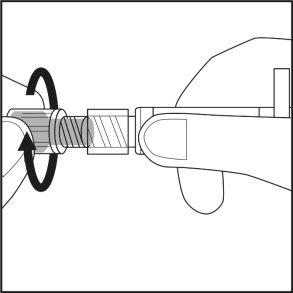
Рисунок 1.
Крок 2:
- Помістіть шприц назад у внутрішню упаковку. Жовтий розчин не буде витікати.
- Перевірте мітку пластикового корпусу, який містить голку. Мітка повинна бути цілою (див. рисунок 2).
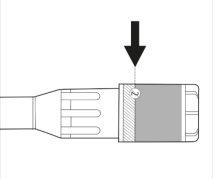
Рисунок 2.
Крок 3:
- Видаліть кришку пластикового корпусу голки, повернувши її та потягнувши далі. Див. рисунок 3.1
- Поверніть голку разом з пластиковим корпусом у шприці до тих пір, поки не досягне кінця. Див. рисунок 3.2
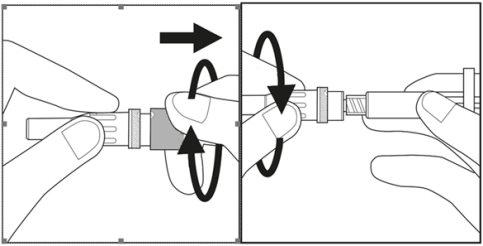
Рисунок 3.1 Рисунок 3.2
Крок 4:
- Виберіть місце ін'єкції на ділянці живота або стегна та очистіть його ватним тампоном, змоченим у спирті. Не торкайтеся цієї ділянки перед ін'єкцією (див. рисунки 4.1 та 4.2).
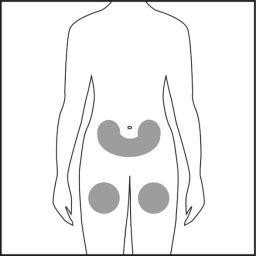
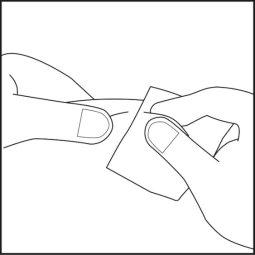
Рисунок 4.1 Рисунок 4.2
Крок 5:
- Видаліть корпус канюлі та покладіть його окремо.

- Не торкайтеся стерильної канюлі. Якщо це трапиться, запитайте у свого лікаря або фармацевта про можливість використання іншої канюлі. Двома пальцями утворіть складку на шкірі та введіть голку майже вертикально.
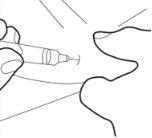
Крок 6:
- Введіть канюлю повністю у складку шкіри. Потім повільно натисніть на поршень вниз та введіть весь ліків під шкіру.
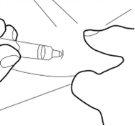
Крок 7:
- Акуратно видаліть канюлю та проведіть ватним тампоном по місці ін'єкції. Не тертьте, оскільки це може викликати подразнення місця ін'єкції.
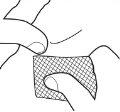
- Щоб уникнути травм, покладіть використаний шприц у контейнер для колючих предметів.

Скільки коштує БЕРТАНЕЛ 7,5 мг/0,75 мл РОЗЧИН ДЛЯ ІН'ЄКЦІЙ У ПЕРЕДНАПОВНЕНИХ ШПРИЦАХ в Іспанії у 2025 році?
БЕРТАНЕЛ 7,5 мг/0,75 мл РОЗЧИН ДЛЯ ІН'ЄКЦІЙ У ПЕРЕДНАПОВНЕНИХ ШПРИЦАХ коштує в середньому 10.88 євро у грудень, 2025 році. Ціна може змінюватися залежно від регіону, аптеки та наявності рецепта. Рекомендуємо перевіряти актуальну вартість у місцевих аптеках або через онлайн-сервіси.
- Країна реєстрації
- Середня ціна в аптеках10.88 EUR
- Діючі речовини
- Потрібен рецептТак
- Виробник
- Інформація є довідковою і не є медичною порадою. Перед прийомом будь-яких препаратів обов'язково проконсультуйтеся з лікарем. Oladoctor не несе відповідальності за медичні рішення, прийняті на основі цього контенту.
- Альтернативи до БЕРТАНЕЛ 7,5 мг/0,75 мл РОЗЧИН ДЛЯ ІН'ЄКЦІЙ У ПЕРЕДНАПОВНЕНИХ ШПРИЦАХФорма випуску: РОЗЧИН ДЛЯ ІН'ЄКЦІЙ, 10 мг/ 1 млДіючі речовини: methotrexateВиробник: Ebewe Pharma Ges.M.B.H. Nfg.KgПотрібен рецептФорма випуску: РОЗЧИН ДЛЯ ІН'ЄКЦІЙ, 15 мгДіючі речовини: methotrexateВиробник: Ebewe Pharma Ges.M.B.H. Nfg.KgПотрібен рецептФорма випуску: РОЗЧИН ДЛЯ ІН'ЄКЦІЙ, 20 мгДіючі речовини: methotrexateВиробник: Ebewe Pharma Ges.M.B.H. Nfg.KgПотрібен рецепт
Аналоги БЕРТАНЕЛ 7,5 мг/0,75 мл РОЗЧИН ДЛЯ ІН'ЄКЦІЙ У ПЕРЕДНАПОВНЕНИХ ШПРИЦАХ в інших країнах
Найкращі аналоги з тією самою діючою речовиною та терапевтичним ефектом.
Аналог БЕРТАНЕЛ 7,5 мг/0,75 мл РОЗЧИН ДЛЯ ІН'ЄКЦІЙ У ПЕРЕДНАПОВНЕНИХ ШПРИЦАХ у Польща
Аналог БЕРТАНЕЛ 7,5 мг/0,75 мл РОЗЧИН ДЛЯ ІН'ЄКЦІЙ У ПЕРЕДНАПОВНЕНИХ ШПРИЦАХ у Україна
Лікарі онлайн щодо БЕРТАНЕЛ 7,5 мг/0,75 мл РОЗЧИН ДЛЯ ІН'ЄКЦІЙ У ПЕРЕДНАПОВНЕНИХ ШПРИЦАХ
Консультація щодо дозування, побічних ефектів, взаємодій, протипоказань та поновлення рецепта на БЕРТАНЕЛ 7,5 мг/0,75 мл РОЗЧИН ДЛЯ ІН'ЄКЦІЙ У ПЕРЕДНАПОВНЕНИХ ШПРИЦАХ – за рішенням лікаря та згідно з місцевими правилами.





